By Paul Bierman and Tammy Rittenour. Bierman is a Fellow of the Gund Institute for Environment, Professor of Natural Resources and Environmental Science, University of Vermont. Rittenour is Professor of Geosciences and Director of Luminescence Lab, Utah State University. Originally published at The Conversation.
About 400,000 years ago, large parts of Greenland were ice-free. Scrubby tundra basked in the Sun’s rays on the island’s northwest highlands. Evidence suggests that a forest of spruce trees, buzzing with insects, covered the southern part of Greenland. Global sea level was much higher then, between 20 and 40 feet above today’s levels. Around the world, land that today is home to hundreds of millions of people was under water.
Scientists have known for awhile that the Greenland ice sheet had mostly disappeared at some point in the past million years, but not precisely when.
In a new study in the journal Science, we determined the date, using frozen soil extracted during the Cold War from beneath a nearly mile-thick section of the Greenland ice sheet.
The timing – about 416,000 years ago, with largely ice-free conditions lasting for as much as 14,000 years – is important. At that time, Earth and its early humans were going through one of the longest interglacial periods since ice sheets first covered the high latitudes 2.5 million years ago.
The length, magnitude and effects of that natural warming can help us understand the Earth that modern humans are now creating for the future.
A World Preserved Under the Ice
In July 1966, American scientists and U.S. Army engineers completed a six-year effort to drill through the Greenland ice sheet. The drilling took place at Camp Century, one of the military’s most unusual bases – it was nuclear powered and made up of a series of tunnels dug into the Greenland ice sheet.
The drill site in northwest Greenland was 138 miles from the coast and underlain by 4,560 feet of ice. Once they reached the bottom of the ice, the team kept drilling 12 more feet into the frozen, rocky soil below.
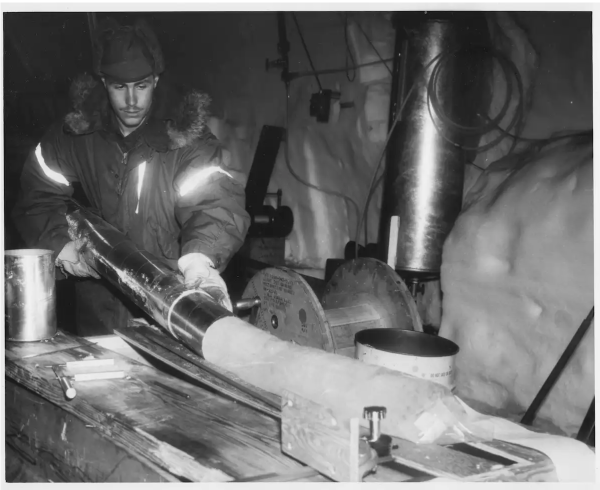
George Linkletter, working for the U.S. Army Corps of Engineers Cold Regions Research and Engineering Laboratory, examines a piece of ice core in the science trench at Camp Century. The base was shut down in 1967. U.S. Army Photograph
In 1969, geophysicist Willi Dansgaard’s analysis of the ice core from Camp Century revealed for the first time the details of how Earth’s climate had changed dramatically over the last 125,000 years. Extended cold glacial periods when the ice expanded quickly gave way to warm interglacial periods when the ice melted and sea level rose, flooding coastal areas around the world.
For nearly 30 years, scientists paid little attention to the 12 feet of frozen soil from Camp Century. One study analyzed the pebbles to understand the bedrock beneath the ice sheet. Another suggested intriguingly that the frozen soil preserved evidence of a time warmer than today. But with no way to date the material, few people paid attention to these studies. By the 1990s, the frozen soil core had vanished.
Several years ago, our Danish colleagues found the lost soil buried deep in a Copenhagen freezer, and we formed an international team to analyze this unique frozen climate archive.
In the uppermost sample, we found perfectly preserved fossil plants – proof positive that the land far below Camp Century had been ice-free some time in the past – but when?
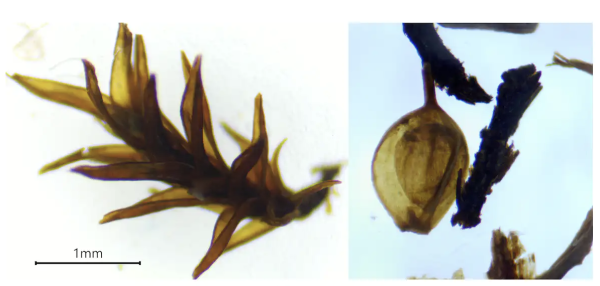
Exquisitely preserved fossils of more than 400,000-year-old moss, on the left, and a sedge seed on the right, found in the soil core from beneath the Greenland ice sheet, help tell the story of what lived there when the ice was gone. Halley Mastro/University of Vermont
Dating Ancient Rock, Twigs and Dirt
Using samples cut from the center of the sediment core and prepared and analyzed in the dark so that the material retained an accurate memory of its last exposure to sunlight, we now know that the ice sheet covering northwest Greenland – nearly a mile thick today – vanished during the extended natural warm period known to climate scientists as MIS 11, between 424,000 and 374,000 years ago.
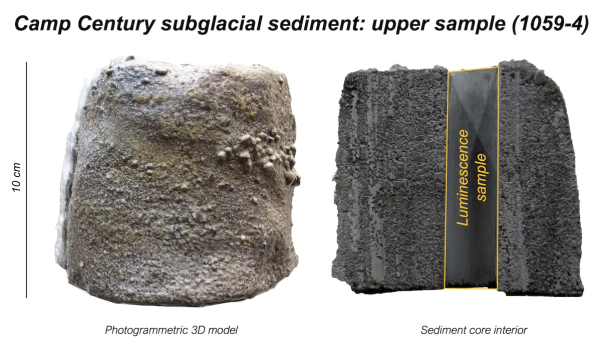
The uppermost sample of the Camp Century sub-ice sediment core tells a story of vanished ice and tundra life in Greenland 416,000 years ago. Andrew Christ/University of Vermont
To determine more precisely when the ice sheet melted away, one of us, Tammy Rittenour, used a technique known as luminescence dating.
Over time, minerals accumulate energy as radioactive elements like uranium, thorium, and potassium decay and release radiation. The longer the sediment is buried, the more radiation accumulates as trapped electrons.
In the lab, specialized instruments measure tiny bits of energy, released as light from those minerals. That signal can be used to calculate how long the grains were buried, since the last exposure to sunlight would have released the trapped energy.
Paul Bierman’s laboratory at the University of Vermont dated the sample’s last time near the surface in a different way, using rare radioactive isotopes of aluminum and beryllium.
These isotopes form when cosmic rays, originating far from our solar system, slam into the rocks on Earth. Each isotope has a different half-life, meaning it decays at a different rate when buried.
By measuring both isotopes in the same sample, glacial geologist Drew Christ was able to determine that melting ice had exposed the sediment at the land surface for less than 14,000 years.
Ice sheet models run by Benjamin Keisling, now incorporating our new knowledge that Camp Century was ice-free 416,000 years ago, show that Greenland’s ice sheet must have shrunk significantly then.
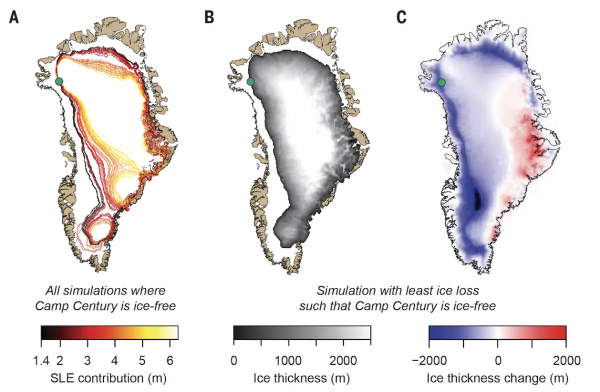
Model results show possible extents of a shrunken Greenland ice sheet when Camp Century was ice-free 416,000 years ago. SLE is sea-level equivalent of the melted ice in meters. Reprinted with permission from AJ Christ et al., Science 381:6655 (2023)
At minimum, the edge of the ice retreated tens to hundreds of miles around much of the island during that period. Water from that melting ice raised global sea level at least 5 feet and perhaps as much as 20 feet compared to today.
Warnings for the Future
The ancient frozen soil from beneath Greenland’s ice sheet warns of trouble ahead.
During the MIS 11 interglacial, Earth was warm and ice sheets were restricted to the high latitudes, a lot like today. Carbon dioxide levels in the atmosphere remained between 265 and 280 parts per million for about 30,000 years. MIS 11 lasted longer than most interglacials because of the impact of the shape of Earth’s orbit around the sun on solar radiation reaching the Arctic. Over these 30 millennia, that level of carbon dioxide triggered enough warming to melt much of the Greenland’s ice.
Today, our atmosphere contains 1.5 times more carbon dioxide than it did at MIS 11, around 420 parts per million, a concentration that has risen each year. Carbon dioxide traps heat, warming the planet. Too much of it in the atmosphere raises the global temperature, as the world is seeing now.
Over the past decade, as greenhouse gas emissions continued to rise, humans experienced the eight warmest years on record. July 2023 saw the hottest week on record, based on preliminary data. Such heat melts ice sheets, and the loss of ice further warms the planet as dark rock soaks up sunlight that bright white ice and snow once reflected.
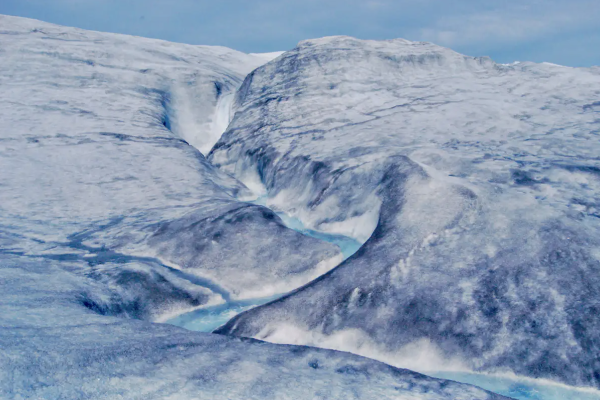
At midnight in July, meltwater pours over the Greenland ice sheet in a meandering channel. Paul Bierman
Even if everyone stopped burning fossil fuels tomorrow, carbon dioxide levels in the atmosphere would remain elevated for thousands to tens of thousands of years. That’s because it takes a long time for carbon dioxide to move into soils, plants, the ocean and rocks. We are creating conditions conducive to a very long period of warmth, just like MIS 11.
Unless people dramatically lower the concentration of carbon dioxide in the atmosphere, evidence we found of Greenland’s past suggests a largely ice-free future for the island.
Everything we can do to reduce carbon emissions and sequester carbon that is already in the atmosphere will increase the chances that more of Greenland’s ice survives.
The alternative is a world that could look a lot like MIS 11 – or even more extreme: a warm Earth, shrinking ice sheets, rising sea level, and waves rolling over Miami, Mumbai, India and Venice, Italy.


If the MIS 11 warm period lasted so long because of the effects of the shape of the Earth’s orbit at that time, how much meaning is there in comparing that age to the current one without taking the current shape of the Earth’s orbit into account?
The research itself is fascinating and the climate change risks are real. However, constantly adding on a climate change warning even when the particular information does not really support it could be counterproductive. It would definitely be anti-democratic and disrespectful.
The earths orbit around the sun, annually, is elliptical. And the earth is tilted ~28 degrees on its axis. (the tilt is what makes the Northern hemisphere colder/darker/ further from the Sun in “Winter”.) My impression is that the author is indicating it will take a long time to cool the planet once it is overheated—especially with the increased CO2 levels.
Earth orbit: https://geography.name/wp-content/uploads/2016/08/4574857.jpg
Hard to believe that that 12 feet of frozen soil was hardly examined and even went MIA for several years. Still, it is valuable being able to study it now. I wonder if the future of Greenland is to be farmlands. That is, if all those glaciers have not scraped all the soil away first. I sometimes wonder if the future of our planet is to be a combination of both a jungle and desert planet. It would be one or another. But looking at the heatwaves hitting the northern hemisphere right now, it may be a lot sooner than you might think.
The planet’s future will most likely be one largely created by human civilization, but absent that same civilization. Jungles and deserts are merely human constructs, and such terms will have no meaning. It is a possibility more terrible than most people can bear. No one will be left in the future to argue, as people once did, ‘Who lost China?’ Who lost earth? can only be asked now, by the living, It’s a terrible reckoning to be faced.
Excellent.
Warming and cooling have certainly occurred in past and will do so in the future on our closed-loop Gaia.
Never before have there been 8 Billions ‘sentient’ ewww-mans to witness and suffer through and ponder it.
Truth there. The impact on humans and where they can live comfortably is the real problem with these changes. Agriculture takes time to adjust as optimum growing regions change, but we’re good at stuff like that. What we’re not good at is tolerating large scale migration as regions become more and more inhospitable to human habitation. Immigration is already a flash point across the globe, it only gets worse from here.
I can believe it. I worked with lunar “soil” in grad school (late 90s) that hadn’t been touched in decades. At least it was stored properly.
Geological field work happens in short periods of intense activity. There’s often so many samples that the ones at the bottom of the box don’t get looked at until years later, or longer if they get shuffled off into storage to make way for the next season’s samples.
“inflation is not properly measured for various technical/political reasons”
There’s an understatement. Wonder how Andrea Mitchell would respond if Alan Greenspan got home from the grocery, set some tins of cat food on the counter, and announced, “Honey, I got the steaks!”.
The article above indeed fails to mention that we are in a similar orbital situation today as during MIS 11. If anything, the article understates current climate change risks given the vastly higher levels of atmospheric CO2 (my opinion).
Sources
“Marine Isotope Stage 11 (MIS 11) from ∼424,000 to 374,000 yrs ago included one of the longest and warmest interglacials of the last 800,000 yrs, and is a potential analogue for the Holocene due to the similarity of Earth’s orbital configuration at this time. ” link
“During Interglacials earth’s orbit is more round. On a 400,000 year cycle earth goes into a prolonged period of time in a round orbit. During the Stagell Interglacial (~420,000 BP-~395,000 BP) earth was in a prolonged round orbit. Earth’s orbital geometry for the past 11,000 years has been similar to the orbit that earth was in during the Stagell Interglacial, suggesting we will remain within an interglacial for tens of thousands of years with or without the influence of anthropogenic greenhouse gases.”
link
Days late, but thank for filling in the missing piece of information.
I just finished reading Daniel Ellsberg’s 2017 book “The Doomsday Machine – Confessions Of A Nuclear War Planner”. Climate change and ecocide can be seen as a longer term risk, while nuclear annihilation may be a short term risk (with no long term to worry about). Few people seem to care about any of the existential risks facing the planet and all of its inhabitants. It’s very strange indeed.
The power to imagine something remarkable on the still-extant-natural-parts-of-the-planet seems to be something TPTB would like to atrophy. Call it interest I guess. Social media pays lip service allowing Go-Pro shares in eg; but, while there’s too much on AI, there are obviously too few doubts shared in regard to it. They keep suckering people with utopian tech just as they’ve done with the tech shipped off to Ukraine. Which is why I’m looking forward to reading this NC article on small nukes.
Wendell Berry https://www.facebook.com/photo/?fbid=10230520877545207&set=a.1179193879526
When they’re discussing an ice-free period between 424,000 and 374,000 years ago and
sediment that was exposed at the land surface for less than 14,000 years, I’d like to know what their analytical confidence intervals and temporal resolution are before they start predicting modern doomsday scenarios.
It is also the case that during the Eemian interglacial, or warm period, between ice ages roughly 120,000 years ago (ie the warm period before the one we are now currently in) there is strong evidence the earth was up to 2 degrees C warmer than today and the sea levels 30 to 50 feet higher. I find it rather fascinating that the immediate default view is that because of previous warm periods with much lower CO2 levels we need to be entirely apoplectic about today’s warming, rather than perhaps concluding that these warm periods might be independent of CO2 levels – ie that current climate change is a natural event that has now occurred at least 20 times in the last 2 million years (human’s existence) and that in fact while the changes are real and the impacts real as well, it might be better to be focusing on mitigation steps we might take instead of only thinking about blocking the sun or entirely reconfiguring the modern industrial state back to the stone age – steos such as, for example, developing a hydrogen based power system, developing an economic system built around lasting and sustainability, and so forth.
This article, offered here I guess somehow as proof that we need to be even more concerned about current warming, actually makes that case that the current warming is a natural cycle and there is little we can do about it except adjust and adapt, as we humans have done many times before.
I believe it’s the rate of change, not the change itself that is the concern.
Camp Century was nuclear powered, it was built into the ice. The builders didn’t realize that ice moves and so the structure quickly became deformed and is still moving, with its on site nuclear reactor moving closer to destruction